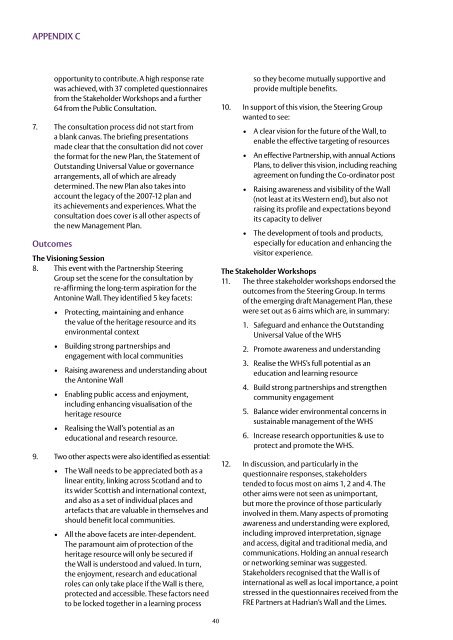The Antonine Wall Management Plan 2013-18 - Glasgow City Council
The Antonine Wall Management Plan 2013-18 - Glasgow City Council
The Antonine Wall Management Plan 2013-18 - Glasgow City Council
Create successful ePaper yourself
Turn your PDF publications into a flip-book with our unique Google optimized e-Paper software.
appendix c<br />
opportunity to contribute. A high response rate<br />
was achieved, with 37 completed questionnaires<br />
from the Stakeholder Workshops and a further<br />
64 from the Public Consultation.<br />
7. <strong>The</strong> consultation process did not start from<br />
a blank canvas. <strong>The</strong> briefing presentations<br />
made clear that the consultation did not cover<br />
the format for the new <strong>Plan</strong>, the Statement of<br />
Outstanding Universal Value or governance<br />
arrangements, all of which are already<br />
determined. <strong>The</strong> new <strong>Plan</strong> also takes into<br />
account the legacy of the 2007-12 plan and<br />
its achievements and experiences. What the<br />
consultation does cover is all other aspects of<br />
the new <strong>Management</strong> <strong>Plan</strong>.<br />
Outcomes<br />
<strong>The</strong> Visioning Session<br />
8. This event with the Partnership Steering<br />
Group set the scene for the consultation by<br />
re-affirming the long-term aspiration for the<br />
<strong>Antonine</strong> <strong>Wall</strong>. <strong>The</strong>y identified 5 key facets:<br />
•<br />
•<br />
•<br />
•<br />
•<br />
Protecting, maintaining and enhance<br />
the value of the heritage resource and its<br />
environmental context<br />
Building strong partnerships and<br />
engagement with local communities<br />
Raising awareness and understanding about<br />
the <strong>Antonine</strong> <strong>Wall</strong><br />
Enabling public access and enjoyment,<br />
including enhancing visualisation of the<br />
heritage resource<br />
Realising the <strong>Wall</strong>’s potential as an<br />
educational and research resource.<br />
9. Two other aspects were also identified as essential:<br />
•<br />
•<br />
<strong>The</strong> <strong>Wall</strong> needs to be appreciated both as a<br />
linear entity, linking across Scotland and to<br />
its wider Scottish and international context,<br />
and also as a set of individual places and<br />
artefacts that are valuable in themselves and<br />
should benefit local communities.<br />
All the above facets are inter-dependent.<br />
<strong>The</strong> paramount aim of protection of the<br />
heritage resource will only be secured if<br />
the <strong>Wall</strong> is understood and valued. In turn,<br />
the enjoyment, research and educational<br />
roles can only take place if the <strong>Wall</strong> is there,<br />
protected and accessible. <strong>The</strong>se factors need<br />
to be locked together in a learning process<br />
so they become mutually supportive and<br />
provide multiple benefits.<br />
10. In support of this vision, the Steering Group<br />
wanted to see:<br />
•<br />
•<br />
•<br />
•<br />
A clear vision for the future of the <strong>Wall</strong>, to<br />
enable the effective targeting of resources<br />
An effective Partnership, with annual Actions<br />
<strong>Plan</strong>s, to deliver this vision, including reaching<br />
agreement on funding the Co-ordinator post<br />
Raising awareness and visibility of the <strong>Wall</strong><br />
(not least at its Western end), but also not<br />
raising its profile and expectations beyond<br />
its capacity to deliver<br />
<strong>The</strong> development of tools and products,<br />
especially for education and enhancing the<br />
visitor experience.<br />
<strong>The</strong> Stakeholder Workshops<br />
11. <strong>The</strong> three stakeholder workshops endorsed the<br />
outcomes from the Steering Group. In terms<br />
of the emerging draft <strong>Management</strong> <strong>Plan</strong>, these<br />
were set out as 6 aims which are, in summary:<br />
1. Safeguard and enhance the Outstanding<br />
Universal Value of the WHS<br />
2. Promote awareness and understanding<br />
3. Realise the WHS’s full potential as an<br />
education and learning resource<br />
4. Build strong partnerships and strengthen<br />
community engagement<br />
5. Balance wider environmental concerns in<br />
sustainable management of the WHS<br />
6. Increase research opportunities & use to<br />
protect and promote the WHS.<br />
12. In discussion, and particularly in the<br />
questionnaire responses, stakeholders<br />
tended to focus most on aims 1, 2 and 4. <strong>The</strong><br />
other aims were not seen as unimportant,<br />
but more the province of those particularly<br />
involved in them. Many aspects of promoting<br />
awareness and understanding were explored,<br />
including improved interpretation, signage<br />
and access, digital and traditional media, and<br />
communications. Holding an annual research<br />
or networking seminar was suggested.<br />
Stakeholders recognised that the <strong>Wall</strong> is of<br />
international as well as local importance, a point<br />
stressed in the questionnaires received from the<br />
FRE Partners at Hadrian’s <strong>Wall</strong> and the Limes.<br />
40












![Elgin Cathedral Wedding Brochure [pdf, 544kb] - Historic Scotland](https://img.yumpu.com/22301571/1/190x151/elgin-cathedral-wedding-brochure-pdf-544kb-historic-scotland.jpg?quality=85)



